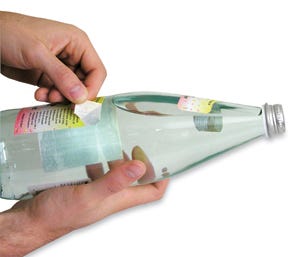A Materials Issue
January 30, 2014
|
Often blamed for "gumming up" recycling processes, label adhesives can vary in their compatibility with current recycling processes. |
Encouraged by eco-conscious retailers and end users, packaging suppliers are seeking alternative materials with less impact on the environment. Often, they are asked about the recyclability of the packaging they manufacture.
When it comes to labels—especially those on pressure-sensitive stock—it is important to examine all aspects of the recycling process. This includes how the recycling system works with labels; how label converters and packaging engineers can help labels move through the recycling stream efficiently; and, finally, how it may be possible to create a label designed for recycling right from the start.
The recycling stream
Materials pass through most U.S. recycling facilities in a similar fashion: Curbside collection programs bring materials to a municipal recycling facility (MRF); collected materials, which range from plastic to glass to paper, are sorted then given or sold, depending on their value, to recyclers.
Plastic bottles—one of the most common sources of recycled plastic—are taken by recyclers to processing plants. They are washed and separated in hot, soapy water to remove as many contaminants as possible. The bottles then are ground up, with the labels still attached, and washed once again to remove as much label material as possible. According to the Association for Postconsumer Plastic Recyclers ([APPR] www.plasticsrecycling.org), it is estimated that up to 95 percent of all label materials are removed at this point in the process. In most cases, the label material is landfilled. In some instances, plastics such as polypropylene (PP) are separated from the rest of the waste material and used for recycling.
Three roads to higher recyclability
While plastic recycling experts' opinions vary, they generally agree that packagers have three opportunities to improve the odds that removed label material will be recycled instead of landfilled. Packaging operations can choose label materials that have high value to recyclers; they can specify adhesives optimized for recycling; and packagers can ask for inks and varnishes that will not contaminate recycled plastic.
By boosting the market value of reclaimed label material, packagers can help create an economic incentive for recyclers to keep that material out of landfills. “From a material recovery perspective, the more of any one type of material in the recycling stream, the more important the need for a solution,” Jeff McLaughlin, vice chairman of the National Assn. for Polyethylene Terephthalate Container Resources (www.NAPCOR.com) explains. “If all labels in the marketplace were on PET (polyethylene terephthalate) film substrates [for example], the industry would have a compelling volume of labels to recover.”
Compatibility with the container recycling processes also is important. In some cases, this involves choosing labels that separate easily from their containers; in other cases, it means choosing labels that can be recycled along with the container. As Jon Stephens, a member of the board of directors for the APPR explains, using materials that sink in water, such as polylactic acid (PLA), polyethylene terephthalate glycol (PETG) or polystyrene (PS), is not good for PET recycling. On the other hand, sinking labels are fine for high-density polyethylene (HDPE) bottles, but HDPE labels are even better.
Adhesive selection is another critical factor. While it is generally presumed that adhesives will “gum up” the recycling process, there are adhesives that promise greater compatibility with current recycling processes. McLaughlin sees value in adhesives designed to wash off of containers with hot water. As he explains, “Potentially, they could allow for shorter wash times, thus increasing throughput at the recycling plant, which would boost the value of the material to the recycler.”
Explaining that washable adhesives need certain performance characteristics to add potential value to their recyclability, Stephens says: “Adhesives should release from the PET or HDPE surface at 70- to 80-degree Celsius, with caustic and surfactants present. Ideally, the adhesive stays with the label. Adhesive that does disperse must not redeposit on the washed PET or HDPE flakes.”
Label inks and varnishes that contaminate the wash water during processing can negatively impact both the label and the container's recyclability. To evaluate how much of a label's inks and varnishes can bleed during the recycling process, APR has developed and posted a test protocol on its website.
Learning for success
Trade associations, recyclers, packaging consultants and label material suppliers are working together to educate packaging engineers, consumer goods companies and end users about label-recycling options. For example, the Tag and Label Manufacturers Institute (www.tlmi.com), NAPCOR and APPR are establishing and promoting guidelines for material choices.
These groups encourage bottlers to use only PP labels on PET bottles. The amount of recyclable PP coming off of bottles may encourage more recyclers to steer this material away from landfills.
The eco-sensitive label
So, is it possible to create a “recyclable” label? In a word, yes.
The key to increasing a label's recyclability lies in making the appropriate material, adhesive and ink-and-varnish choices. Packagers should choose materials that have high value to recyclers, specify adhesives that facilitate label removal and do not contaminate recycled plastic, and choose inks that meet APPR's bleeding labels protocol.
This article was edited by Packaging Digest staff and written by Avery Dennison marketing leader Amy Kovach and market research manager Sam Brown.
Brown conducts trend analysis for Avery Dennison, and Kovach leads the marketing, communication and education strategy for green growth and sustainable platform development for Avery Dennison, Fasson Roll North America.
More information is available: |
Association for Postconsumer Plastic Recyclers, 202/316-3046. www.plasticsrecycling.org. |
National Assn. for PET Container Resources, 707/996-4207. www.napcor.com. |
Tag and Label Manufacturers Institute, 630/357-9222. www.tlmi.com. |
You May Also Like



